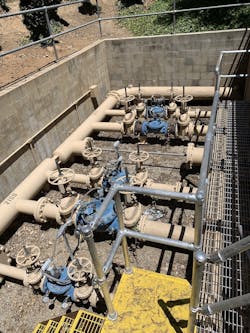About the author:
Jeff Varney is regional sales engineer for Cla-Val. Varney can be reached at [email protected] or 949.923.0656.
The city of Redlands, California, is a city at the base of the San Bernardino mountains in Southern California. It is located 60 miles north east of Los Angeles and 45 miles west of Palm Springs.
The city was incorporated in 1888 and was known as the “City of Millionaires” by the early 1900s. It was the Washington Navel Orange growing capital of the world and the citrus industry was the focus of the economy. The railways brought a land boom to the area, and the arrival of Pacific Electric Railway with service to Los Angeles, bought greater prosperity to the town as vacation homes were built for the wealthy.
The city is still thriving today with companies, such as Esri—a large GIS software company—Amazon and La-Z-Boy having operations in the city. Today, the city still boasts some spectacular historic buildings and has a scenic downtown area that is hub for tourism.
“It’s a perfect place to live and work,” said Tim Neumann, plant mechanic II for the city and a seventh-generation resident. “[Just] 45 minutes from the beach, and you can be snowboarding in the mountains in 45 minutes too.”
Two Plants, Seven Pressure Zones
Water production and distribution is managed by the Municipal Utilities & Engineering Department and is supplied from two water supplies, Millcreek and the Santa Anna River. Treatment is provided at two conventional water treatment plants (WTP), Tate WTP and Hinckley WTP, each capable of producing approximately 14 million gallons per day (mgd). Water is then fed into seven different pressure zones due to elevation changes through a series of pump stations.
These pressure zones and pump stations require on-going inspections, maintenance and periodic equipment overhauls. A number of years ago, Neumann was asked if he would incorporate looking after 18 automatic control valves into his work schedule. These valves were pressure reducing and pressure sustaining valves, which he quickly realized had not had real maintenance in a number of years. This is not unusual in many city water departments as staffing levels have reduced over the years and operations can get too busy with repairs and breakdowns. Maintenance can easily lose focus.
The Life of a Spreadsheet
Neumann decided the only way to stay on top of the situation was to produce a maintenance database and record everything relating to the valves. This he produced in a spreadsheet program, which he wrote himself and spent hours inputting records and pictures of the valves. He felt this was a prudent exercise as it would also provide a written log for future operations personnel if he was not available.
Fast forward a few years and this method was successful enough that he became responsible for 92 control valves that he was keeping data base records for. While the program was working, it was not a particularly efficient way to be logging the
valve information.
In 2019, Neumann contacted the regional sales engineer at Cla-Val about available programs on the market that would make this task easier or more efficient. The timing was fortuitous as Cla-Val had begun to launch its brand new Link2Valves asset management software for control valves. The program allows an operator to log data and photographs using a mobile phone app. The information is then uploaded to a database that is accessible via a dedicated website portal in addition to the app.
Neumann started using the app immediately to record all the valve settings, log the maintenance performed, take site and valve pictures, as well as the geolocation of the valve. When a valve is due for maintenance, it graphically lets him know by changing the map icon color. It even sends an email to him with a reminder. Neumann was able to quickly implement the program because it is free to use, so without the burden of cost, he could test it out with little risk.
Neumann said he enjoys using the software and it has helped in his budget process to ensure he has everything included for the upcoming year. He also sees this as helping when it is time to transfer system knowledge to new employees or the next generation of plant mechanics in Redlands.
